
יִחִָרְָזְִמִַּהַ UK SPECIAL EDITION WEEKEND OF INSPIRATION
WITH GRATEFUL THANKS TO THE FOUNDING SPONSORS OF HAMIZRACHI THE LAMM FAMILY OF MELBOURNE, AUSTRALIA
www.mizrachi.org
office@mizrachi.org
+972 (0)2 620 9000
NASI
Rabbi Yosef Zvi Rimon
CO-PRESIDENT
Rabbi Yechiel Wasserman
CHAIRMAN
Mr. Harvey Blitz
EXECUTIVE CHAIRMAN
Rabbi Doron Perez
DEPUTY CEO
Rabbi Danny Mirvis
EDUCATIONAL DIRECTORS
Rabbi Reuven Taragin
Rabbanit Shani Taragin
World Mizrachi is the global Religious Zionist movement, spreading Torat Eretz Yisrael across the world and strengthening the bond between the State of Israel and Jewish communities around the world.
Based in Jerusalem and with branches across the globe, Mizrachi – an acronym for merkaz ruchani (spiritual center) – was founded in 1902 by Rabbi Yitzchak Yaakov Reines, and is led today by Rabbi Doron Perez. Mizrachi’s role was then and remains with vigor today, to be a proactive partner and to take personal responsibility in contributing to the collective destiny of Klal Yisrael through a commitment to Torah, the Land of Israel and the People of Israel.
www.mizrachi.org.uk
uk@mizrachi.org 020 8004 1948
PRESIDENT
Chief Rabbi Sir Ephraim Mirvis KBE
CHAIR OF TRUSTEES
Steven Blumgart
CHIEF EXECUTIVE
Rabbi Andrew Shaw
BOARD
Michelle Bauernfreund
Matti Fruhman
Andrew Harris
Grant Kurland
Sean Melnick
David Morris To dedicate an issue of HaMizrachi in memory of a loved one


INSIDE 4 Rabbi Doron Perez 19 Rabbanit Shani Taragin 38 Kids Corner
or in celebration of a simcha, please email uk@mizrachi.org REGULARS 4 Rabbi Doron Perez 27 Rabbanit Shani Taragin 38 Rabbi Reuven Taragin 49 Sivan Rahav-Meir 56 Aliyah Diaries 59 Food from Israel 61 Crossword 62 Hallel and Shammai EDITOR Rabbi Elie Mischel editor@mizrachi.org | MANAGING EDITOR Rabbi Aron White CREATIVE DIRECTOR Leah Rubin | PROOFREADER Daniel Cohen HaMizrachi is available to read online at mizrachi.org/hamizrachi PUBLISHED BY WORLD MIZRACHI IN JERUSALEM HaMizrachi seeks to spread Torat Eretz Yisrael throughout the world. HaMizrachi also contains articles, opinion pieces and advertisements that represent the diversity of views and interests in our communities. These do not necessarily reflect any official position of Mizrachi or its branches. If you don't want to keep HaMizrachi, you can double-wrap it before disposal, or place it directly into genizah (sheimos). In partnership with SEE PAGES 5–13 FOR MORE DETAILS 2 |
The Weekend of Inspiration 2024
Rabbi Andrew Shaw
Never in all the years of Mizrachi UK running the Weekend of Inspiration did we think that it would be needed this year in the way that it is.
After October 7th, the world changed, and not for the better. The scenes we have witnessed recently across student campuses, in numerous cities and online are shocking and disturbing.
However, the response from the Jewish community has not been to cower and hide but to proudly express our love for Israel and support for her in these difficult times.
I cannot think of a better way to respond to the current situation than to embrace our thirty-six exceptional educators from Israel who have come to uplift, inspire and strengthen.
Even before the current situation, we had a vision to improve the Weekend of Inspiration, to make sure more shuls were involved, to expand our programme on Friday and Sunday and to engage more and more people.

So, what does 2024 bring? First, we have brought our biggest delegation of thirty-six educators who will spend Shabbat in almost fifty communities and speaking to nearly 10,000 people in four cities across the UK.
The Day of Inspiration is now in SEVEN locations, making it more local to many people. We have full day conferences in Edgware and Hendon and half day conferences in Borehamwood, Bushey, Kinloss, Manchester and South Hampstead. The idea is that you buy a ticket and you can travel round London choosing from a wonderful array of speakers, you can even end up in Manchester for the final talk of the weekend! Or you can decide to stay in one venue all day – the choice is yours.
During that day there will be almost 100 shiurim with a combined 32 hours and of course a choice of 35 educators – it is a day not to be missed.
Inside this special HaMizrachi – Weekend of Inspiration edition – you will find the full schedules of all three locations on


Sunday as well as some powerful articles from many of the speakers coming this Shabbat and essays connecting us to this special time of year, Yom HaAtzmaut.
I very much hope you are inspired by the Mizrachi educators over Shabbat and I hope to see you at one of more of the seven venues on Sunday!
It will be a day to remember!
Shabbat Shalom



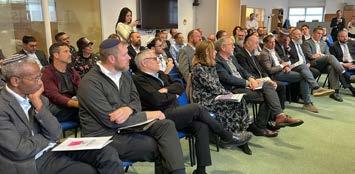 Rabbi Andrew Shaw is the Chief Executive of Mizrachi UK.
Rabbi Andrew Shaw is the Chief Executive of Mizrachi UK.
Weekend of Inspiration, 2023
RABBI SHAW WILL BE IN WESTERN MARBLE ARCH FOR SHABBAT
| 3
On behalf of all us at World Mizrachi, we wish all involved in the Mizrachi UK Weekend of Inspiration, great success for this remarkable event.
A big yishar koach to our friends Rabbi Andrew Shaw, Chief Executive of Mizrachi UK, and his team, together with Chairman of the Board of Trustees, Mr Steven Blumgart, and the Board for their wonderful work in taking Mizrachi to great heights in the UK in general and in particular for this incredible event.
Bringing so many world-class speakers to scores of communities across the UK is a tremendous undertaking and a great achievement on so many levels.
This year, the tragic events of Shabbat Simchat Torah / the 7th of October have made this Yom HaAtzmaut even more meaningful. The pain and price of Yom HaZikaron year has been amongst the most dangerous and painful that the State of Israel has ever experienced. We ought never to take for granted the astonishing ongoing miracle and privilege of sovereign Jewish state in Eretz Yisrael.
May the Torah and Torat Eretz Yisrael learned across UK Jewry this weekend be a great zechut for all our soldiers, bring healing to the wounded, comfort to the families of those who have fallen and the speedy return of all our hostages.
I am grateful to be among many of our World Mizrachi leadership and educational team staff participating in this program – Our Nasi, Rav Yosef Zvi Rimon shlit”a, Rav Danny Mirvis, Acting CEO, Rav Reuven and Rabbanit Shani Taragin, our Educational Directors, Rav Binyamin Zimmerman, head of our Musmachim program, Rav Bentzi Mann, director of our Schools Department – amongst the illustrious rabbis and educators, foremost amongst them Rav Hershel Schachter shlit”a – a tremendous zechut
Shabbat Shalom and Behatzlacha Raba!
Rabbi Doron Perez


Rabbi Doron Perez is the Executive Chairman of World Mizrachi.
RABBI PEREZ WILL BE IN EDGWARE FOR SHABBAT
4 |

TO PURCHASE To purchase Tzurba volumes in Israel go to tzurbaolami.com/shop FOR MORE INFO For more info about Tzurba please contact neil@tzurbaolami.com Tzurba Volume 18 e third volume of Hilchot Shabbat topics WHO FELL TOGETHER IN GAZA PROTECTING ERETZ YIS EL AND AM YIS EL NEW! Volume 18 is available for purchase on tzurbaolami.com/shop Outside of Israel, Tzurba volumes are available for purchase on Amazon



9:45
9:50 - 10:35
Preparing Mekorot for shiur with Rav Hershel Schachter
10:40 - 11:25 Rav Hershel Schachter shiur
11:30 - 12:15
Rav Reuven Taragin
Where Judaism Begins: A Shiur and Book Launch
Rabbanit Shani Taragin Sticks, Stones and Dry Bones: Revisiting Prophecies
Rav Reuven Taragin
Israel At War: Feeling and Reflecting
Rav Gidon Weitzman Finding Faith in a Complex World
12:20 - 13:10 Q&A with Rav Hershel Schachter 13:10

14:00 - 14:45
Beatie Deutch Becoming your Best Self
Rav Jesse Horn Sefirat HaOmer: A Brisker Perspective
14:50 - 15:35
15:40 - 16:25 Our work since October 7th - Rav Yosef Zvi Rimon,
Rav Benji Levy
16:30 - 17:15
17:20 - 18:05
18:10 - 19:00
My daughter’s liver transplant: How to plan and deal with it when things don’t go to plan
Rav Shlomo Brody
Does Halakha Recognize "Quality of Life"? Great Debates in Medical Ethics
Rav Menachem Leibtag
The 'stranger' in the BibleJew or Gentile? & why it makes a difference!
Rav Binyamin Zimmerman
The IDF's Secret WeaponsAn Army and Arsenal of Torah Scrolls
Rav Elli Fischer
An Intellectual Portrait of Rabbi Nachum Rabinovich Rabbi Sacks' Rebbe
Dr Tova Ganzel Malachi: “I have shown you love, says Hashem, and yet you ask, how?
19 MAY 2024 Hendon
Rabbi Andrew Shaw - Welcome
Rav Assaf Bednarsh
The Unification of Jerusalem
ELIAD - One kid, a thousand hearts
Rabbanit Shani Taragin
Chorev, Churva and Charuv:
Planting and Praying
Rav Gidon Weitzman
A pidyon Haben in AlabamaDefining the beginning of life
Rav Shlomo Brody
The cause of antisemitism? A case study of Ethiopian Jews
Rav Shlomo Brody
End-of-Life Care: Halakhic information every Jew should know Lunch
Schachter & Rav Yosef Zvi Rimon moderated by Dayan Zobin

Rav Menachem Leibtag
Themes in the Bible that explain
Rav Doron Perez
Rav Danny Mirvis Who was left out of Pirkei Avot and Why?
Rimon, Rav Binyamin Zimmerman, Nitsana Darshan-Leitner hosted by Dayan Zobin
Rav Shimshon Nadel
Rav Binyamin Zimmerman
Lag B'Omer's Message for
Bar Kochba's Army and Ours
Uncovering the Deeper Value of Medrash: Lot's Failed Exodus
Rav Shimshon Nadel
Are Yom Ha'atzmaut and Yom Yerushalayim halachic holidays?
Too premature to Sing Shirah?
The Song at the Sea and the Miracle of Medinat Yisrael
Rav Doron Chitiz

Rav Benji Levy journey
Rabbanit Leora Bednarsh
The most important part of any
My heart is in the East: Connecting to Israel through prayer
"There's no way that there is more singing in Gaza than here" music and our fallen soldiers

9:45
9:50 - 10:35
Rav Danny Mirvis
The Point of No ReturnLife after 7th October
Rav Jesse Horn
Sefirat HaOmer: A Brisker Perspective
10:40 - 11:25 Rav Yosef
Rav Menachem Liebtag

11:30 - 12:15
12:20 - 13:10
13:10
14:00 - 14:45
14:50 - 15:35
15:40 - 16:25
16:30 - 17:15
17:20 - 18:05
18:10 - 19:00
The 'stranger' in the Bible - Jew or Gentile? & why it makes a difference!
Rav Binyamin Zimmerman
Lag B'Omer's Message for Bar Kochba's Army and Ours
Rav Benji Levy
My daughter’s liver transplant: How to plan and deal with it when things don’t go to plan
A Shiur with Rav Hershel Schachter
Rav Danny Mirvis
Rav Kook and the football controversy
A Shiur with Rav Hershel Schachter
Dr. Carl Hochhauser
Lessons My Patients Taught Me: Insights from the war in Israel and the war on cancer
Rav Menachem Leibtag
Counting the OmerAll about Sinai, or all about the Land of Israel?
Dr Tova Ganzel
Chagai: “I am with you, says the Lord”: Divine Presence in Moments of Crisis
Rav Bentzi Mann
Me'afeila Le'ora – The silver lining behind an awful chapter
Michal Santhouse Moshe, how did you become my leader?
Rabbanit Shani Taragin
Chorev, Churva and Charuv: Planting and Praying
Our work since October 7th: Steve Gar, Rav Bentzi Mann, Darshan-Leitner (Moderated by Rabbi Andrew
Rav Reuven Taragin
Israel At War: Feeling and Reflecting
Rav Sharon Shalom
The global society between identification and identity
19 MAY 2024 Edgware
Welcome : Rabbi Danny Mirvis
Rabbanit Leora Bednarsh
My heart is in the East:
Connecting to Israel through prayer
Rav Benji Levy
The most important part of any journey
Yosef Zvi Rimon - "The IDF - Sparks of Geulah
Geulah"
Rav Jesse Horn
Rav Assaf Bednarsh
The Unification of Jerusalem
Rav Assaf Bednarsh
Pluralism and the Search for Truth
Lunch
Rav Aviad Tabory
Moshe and Yosef: A Tale of Two Jewish Princes
Rav Sharon Shalom
What is the cause of antisemitism? A case study of Ethiopian Jews
Rav Gidon Weitzman

Halakhic challenges of a Jewish State
Rav Shlomo Brody
A Pidyon Haben in AlabamaDefining the Beginning of Life
Rav Elli Fischer
Dr Tova Ganzel
Halakhic Insights into Dilemmas
A Tale of Two Sieges: About Civilian Casualties
Rav Gidon Weitzman
Finding Faith in a Complex World
Israel in Egypt did not change their Name, Language, and Dress: Unpacking a Modern Myth
Jen Airley
Can anyone be a Kohen?
Chabakuk: “I shout to you hamas! and you do not save?”
Rav Aviad Tabory
The Mitzva of Kiddush Hashem nowadays
"Tov Lehodot Lashem" (it is good to praise G-d) - what are we thankful
Rav Doron Chitiz for this year?
Mann, Michal Santhouse, Nitsana
Andrew Shaw)
Devorah Kay
'An eye for an eye' or not? Do we have a choice?"

Rav Reuven Taragin
Where Judaism Begins: A Shiur and Book Launch
Beatie Deutch
Faith, failure and acceptance
Rabbanit Shani Taragin
Redeeming Fields, Families and Festivals
Rav Danny Mirvis
The Kashrut of Whiskey The laws of spirits and the spirit of the law
Rav Bentzi Mann
The Makings of a Holy Army –Halachic questions at times of war

Borehamwood
9:45 - 10:30
10:35 - 11:20
11:25 - 12:10
Rabbanit Rachelle Fraenkel Faith in the Face of Evil
Dr. Carl Hochhauser
Lessons My Patients Taught Me: Insights from the war in Israel and the war on cancer
Rav Doron Perez
Israel - Hope in the face of fear
Rabbanit Devorah Kay
'An eye for an eye' or not? Do we have a choice?
12:15 - 12:55
13:00 - 13:40
Rav Bentzi Mann
The Makings of a Holy Army –Halachic questions at times of war
Nitsana Darshan-Leitner
Gaza. Harvard. The Hague. Fighting the legal street fights for Israel
Rav Benji Levy
Planning for a meaningful life and adapting when things don’t go to plan
Bushey
9:30 - 10:15
10:20 - 11:05
9:00 - 9:45
9:50 - 10:35
10:40 - 11:25


Rav Doron Perez
Israel - Hope in the face of fear
Steve Gar
Unity and the Big Bang
Kinloss
Rav Yosef Zvi Rimon
Rabbanit Karen Hochhauser
Davening when you are all davened out: How to connect to Tefilla in difficult times.
Rav Elli Fischer
An Intellectual Portrait of Rabbi Nachum Rabinovich, Rabbi Sacks' Rebbe
Beatie Deutch Winning the Marathon of Life
19 MAY 2024
South Hampstead
13:00 - 13:55
14:00 - 15:10
15:15 - 15:55
16:00 - 16:45
10:00 - 10:55
Rav Doron Perez Israel - Hope in the face of fear
Jen Airley Life lessons learnt from Sgt Benjamin Airley
Beatie Deutsch Faith, failure and acceptance
Rav Sharon Shalom "Go go keep going and never stop!" - a personal story
Rav Jesse Horn Why Choose a Nation? Why Choose Us?
Steve Gar Unity and the Big Bang
N. Manchester
Rav Doron Chitiz "There's no way that there is more singing in Gaza than here" Music and our Fallen Soldiers
11:00 - 11:55
12:00 - 12:55
Rav Shimshon Nadel Is it too Premature to Sing Shirah? The Song at the Sea and the Modern-Day Miracle of Medinat Yisrael
Rav Shimshon Nadel & Rav Doron Chitiz in conversation with Rav Benjy Rickman
19:30 - 20:15
Rav Doron Perez Israel - Hope in the face of fear



www.mizrachi.org.uk/woi
Are our Parents the Real Thing?
Chief Rabbi Sir Ephraim Mirvis KBE

Why does the Torah repeat something which is so obvious?
At the commencement of Parashat Emor Moshe was instructed “Emor el ha’kohanim b’nei Aharon v’amarta aleihem”, “say to the Kohanim the sons of Aharon, and say unto them”. He’s told twice to say something to the Kohanim. Why “emor v’amarta” – why both?
The Ramban explains that here we have an important principle – it relates to the world of “taharah” and “tumah” – purity and impurity. Keeping the children away from contamination, guaranteeing that they lead a life of kedusha, of holiness, to be imbued with the sacred at all times. Therefore it is something that needs to be repeated, and repeated again – just saying it once won’t be enough.
Our sages in the Talmud give a different suggestion “ emor v’amarta ’, saying and saying again, they say, is “l’hazhir hagedolim al haketanim” – to warn parents with regard to their children. The first “saying” is for Moshe to say it to the parents, and the second “saying” is for the parents to say it to the children – to guarantee the continuity of that instruction through the ages.
The primary arena within which Jewish children are raised and influenced is within the family home.
Rav Moshe Feinstein says something beautiful on this point. With regard to the impact that parents have on their children, it’s not always about formal instruction – in fact, the primary impact that parents have is informally through the example that they set.
Sometimes one might have a particular persona in the workplace, in their community, or within society – and they hope that people will be suitably impressed by what they see. But when you come home, you wind down, you relax – that’s when you become your real self. It’s within the family circle, particularly at times of leisure, that children see their parents for what they actually are.
As a result, children very easily size their parents up – are they sincere or insincere?
Do they speak in a lovely way or do they shout and scream? Do they maintain high standards of morality or not? Are they truly ethical people? When it comes to mitzvot, do they try to cut corners, or are they the real thing?
Our children internalise what they see from the very youngest age. Therefore the primary arena within which Jewish children are raised and influenced is within the family home. “Emor v’amarta” is the instruction whereby we must study, we must learn and we must practice, and through the example we set hopefully we will inspire future generations to do just likewise.


Chief Rabbi Sir Ephraim Mirvis KBE is the Chief Rabbi of the United Hebrew Congregations of the Commonwealth.
14 |

Birkas Hashem
Rabbi Hershel Schachter
The son of the Israelite woman pronounced the Name and blasphemed … Remove the blasphemer to the outside of the camp, and all those who heard shall lean their hands upon his head, and the entire assembly shall stone him. (Vayikra 24:11-14)
Rav Hirsch (Vayikra 24:21) comments on the juxtaposition of the parsha of birkas Hashem to the punishment of one who inflicts a fatal wound on a person or animal: “And a man, if he strikes mortally any human life, he shall be put to death. And one who strikes mortally an animal life shall make restitution” (Vayikra 24:17-18).
The punishment for an aveirah always corresponds to its severity. The disparity between these punishments therefore indicates the higher regard the Torah has for human life over animal life. The placement of the parsha of birkas Hashem as an introduction to these halachos thus teaches that the greater degree of human dignity is based on the tzelem Elokim (image of G-d) that was placed in Man: “Crimes against the human personality are prefaced by birkas Hashem – the sin against the Personality of G-d.”
Previously, Moshe had been told, אל םיקלא ללקת – “You shall not curse Elokim (She- ” mos 22:27). Since םיקלא is taken both as a secular term that refers to judges as well as a sacred term that refers to Hashem, the passuk is an azharah (Scriptural warning) against birkas Hashem, a euphemism for “cursing” Hashem’s Name. Moshe was not informed until this point, however, that the prohibition is a capital offense.
The question of what the punishment should be for birkas Hashem depends on how severe the aveirah of cursing Hashem really is. On the one hand, the passuk in Tehillim (2:4) states in reference to those who conspire against Hashem,
– “He Who sits in heaven will laugh, the Lord will mock them.” From Hashem’s perspective, the curse is completely meaningless. On the other hand, since from the human perspective, such a travesty is extremely detrimental to the fabric of society, birkas Hashem is deemed a very severe aveirah and demands a penalty of execution.
The Mishnah in Sanhedrin (55b-56a) teaches that a megadeif (blasphemer) is not liable to execution unless he actually pronounced the Name of Hashem. Given this, the Mishnah goes on to describe how the megadeif is tried:
Whenever [the judges] examine the witnesses, they do so using a pseudonym, [such as whether the accused said,] “May Yose strike Yose.”
– When the case is completed, however, they do not execute [the blasphemer] based on a pseudonym. Rather, they send everyone out [of the courtroom], and they ask the most eminent of [the witnesses] and say to him, רומא שוריפב תעמשש המ – “State explicitly what you heard [the blasphemer say].” And he says it. Then, the judges stand on their feet, and they tear [their garments] and never repair them. The second [witness] then says, “I too [heard] as he did.”
Throughout the trial, the eidim are examined and the case is discussed without actually mentioning the Name of Hashem; a pseudonym such as “Yose” is used in its place. Rashi explains that the dayanim may not sentence the accused to death based on the testimony they have heard to this point, since it has not yet been stated explicitly that he actually blasphemed the Divine Name. Thus, Rashi interprets the phrase ןידה רמגנ to mean that the dayanim are prepared to issue the gemar din (verdict); it is only after they hear the actual blasphemy that the dayanim deliver the gemar din. This is somewhat difficult, as the words ןידה רמגנ usually connote the completion of a court case, post-sentencing.
The Minchas Chinuch (mitzvah 70) writes that the eidim are examined using a pseudonym both when the megadeif used the Shem HaMeforash (Explicit Name of Hashem), an aveirah liable to misas beis din, as well as when he used one of the
kinuyim (subordinate Names of Hashem, such as Elokim), which is punishable with malkos. In both, the pronounced Name is stated prior to the actual gemar din. This follows Rashi’s approach; the dayanim must hear the giduf in order for the eidus to be complete.
The Minchas Chinuch continues, noting that since the eidim must state the giduf (blasphemy) explicitly before the gemar din, the eidus concerning a megadeif presents an exception to the general rule. Usually, eidim may not retract their testimony after they have completed being examined by the dayanim. At that point, beis din no longer requires any input from the eidim and may conclude the case without them. In our case, however, even after the examination, beis din cannot issue their psak before the eidim pronounce the actual Name used in the giduf. Therefore, the eidim are able to retract their testimony at any time prior to this point. Again, like Rashi, the explicit pronouncement of the giduf by the eidim is necessary for their eidus to be complete and must be performed before the gemar din may be issued.
Adapted from Rav Schachter on the Parsha III.

Rabbi Hershel Schachter is the Rosh Yeshivah of the Rabbi Isaac Elchanan Theological Seminary of Yeshiva University.
RABBI SCHACHTER WILL BE IN HENDON FOR SHABBAT
געלי 'ד קחשי םימשב בשוי
ומל
ןידה רמגנ
| 15
For the Shabbat Table
Rabbi Danny Mirvis
“And you shall keep (םתרמש ) My commandments and you shall perform them” (Vayikra 22:31).
The tautological nature of these words, which appear about half way through this week’s parsha, troubled many of our commentators. Why are we commanded both to “keep the commandments” and to “perform them”?
Rashi explains, based on a Midrash: “‘And you shall keep’ – this is Mishna. ‘And you shall perform’ – this is action” (Rashi, Vayikra 22:31).
According to Rashi, we are not only commanded to actively perform the mitzvot, but to learn about them as well (Mishna).
Whilst the requirement to learn may be important, how is this implied by the word “םתרמשו” – “and you shall keep/guard”?
One possible explanation is that the way we safeguard the mitzvot from generation to generation is through learning. To avoid a situation whereby the transmission
of halacha becomes a game of “Chinese whispers” (“broken telephone”), our performance of mitzvot must be accompanied by Mishna – learning about and understanding the commandments.
The Sefer Agra D’Kalla (by the Dinover Rebbe, Rav Tzvi Elimelech Shapira zt”l) provides an alternative explanation, based on a different understanding of the word “םתרמשו”. In the book of Bereishit, when Yoseph tells his family about his dreams, we are informed:
“And his (Yoseph’s) brothers were jealous of him, and his father (Ya’akov) looked forward to (“shamar”) the matter” (Bereishit 37:11).
Ya’akov Avinu looked forward to the day when Yoseph’s dreams would come true. We therefore see that “shmira” can also mean “anticipation”. In the context of this week’s parsha, the Sefer Agra d’Kalla explains that the way to properly look forward to the performance of mitzvot is to learn about them, so that we will know exactly how to act when the opportunities for mitzvot come our way.
Both of these explanations provide us with important lessons about our performance of the commandments. Keeping the mitzvot should not only be about performing dry rituals. We should eagerly anticipate our opportunities to fulfill mitzvot and learn about the mitzvot in order to add significance to our actions and safeguard the accurate transmission of Jewish tradition to future generations.
Shabbat Shalom!


 Rabbi Danny Mirvis is the Acting CEO of World Mizrachi.
Rabbi Danny Mirvis is the Acting CEO of World Mizrachi.
16 |
RABBI MIRVIS WILL BE IN FINCHLEY FOR SHABBAT
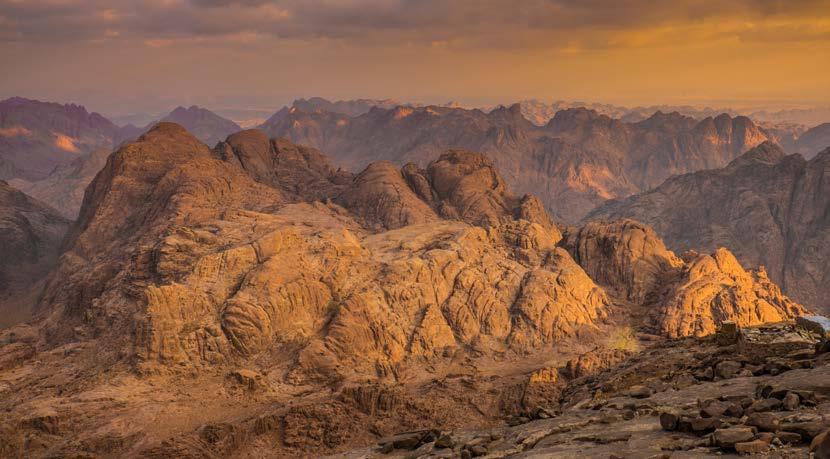
The Four Stages of Ma’amad Har Sinai
Rabbi Menachem Leibtag
Despite the historical prominence and centrality of Ma’amad Har Sinai as perhaps the most important event in Jewish history, we are surprisingly unfamiliar with the chapter in Chumash that describes the specific events thereof. Simply ask yourself, have you ever gone through Shemot perek 19, pasuk by pasuk, in an attempt to follow its progression?
In this week’s shiur, that’s exactly what we’ll do. [By the time we’re done, you’ll understand why most teachers shy away from teaching this chapter (it’s quite complicated).]
Four Sections
Chapter 19 clearly divides into four distinct sections. We will now review each of these sections to verify these definitions and trace the transition from one unit to the next.
Proposition (19:1-8)
Upon Bnei Yisrael’s arrival at Har Sinai (19:1-2), G-d summons Moshe to the mountain and presents the nation with the following proposition:
“If: You will obey Me faithfully and keep My covenant...
Then: You shall be for Me a ‘mamlechet Kohanim v’goy kadosh ’ [a kingdom of priests and a holy nation]...” (19:4-6)
This “proposition” directly relates to the primary theme of Sefer Breishit. Recall G-d’s covenant with the Avot that their offspring will establish a “model” nation [“v’heyitem li segulah m’kol ha’amim”] to represent Him [“mamlechet kohanim”] to all mankind [“ki li kol ha’aretz”]. Therefore, before Bnei Yisrael receive the Torah, they must not only confirm their readiness to obey G-d’s commandments, but also recognize that these mitzvot will facilitate their achievement of this Divine goal.
Whereas a covenant requires the willful consent of both sides, this section concludes with Bnei Yisrael’s collective acceptance of these terms:
“And the people answered together and said, ‘Everything that G-d has spoken we shall keep,’ and Moshe brought the people's answer back to G-d.” (See 19:7-8)
Preparation (19:9-15)
Once Bnei Yisrael accept G-d’s proposal, the next step should be their receiving of His
mitzvot; G-d should now inform Bnei Yisrael of the laws that they have just agreed to observe. First, however, G-d addresses the issue of how Bnei Yisrael will receive these laws:
“And G-d said to Moshe, ‘I will come to you in the thickness of a cloud, in order that the people hear when I speak with you, and in order that they believe in you [i.e., that you are My messenger] forever...’” (19:9)
It appears from this pasuk that G-d plans to use Moshe Rabbeinu as an intermediary to convey His laws to Bnei Yisrael, consistent with Moshe’s role as liaison until this time. Nonetheless, G-d insists that the people “overhear” His communion with Moshe, so that they truly believe that these laws originate from G-d, not Moshe.
Up until this point, the flow of events has progressed in a logical, straightforward manner. But here, in the middle of pasuk 9, we encounter our first “problem.” Now that G-d has informed Moshe of how He plans to convey His laws, we would expect Moshe to immediately go and convey this message to Bnei Yisrael (as he did in 19:7). Instead, 19:9 continues:
“...then Moshe reported the people’s words to G-d.” (19:9)
What’s going on? The second half of this pasuk seems to omit an entire clause – it never tells us what the people responded. Instead, it just says that Moshe relayed the people’s response back to G-d!
This question is so glaring and obvious that Rashi “takes for granted” that everyone would notice it. He begins his commentary by filling in the details of the people’s response, without even explicating the problem in the pasuk:
“ Et divrei ha’am ” [the words of the people]... The people responded: “We want to hear from You [G-d], for one cannot compare hearing from a ‘shliach’ (a messenger) to hearing from the King himself, [or they said,] ‘We want to see our King’!” (See Rashi 19:9 – he is actually quoting the Mechilta.)
Note how Rashi adds an entire unwritten line to this narrative! According to Rashi, Bnei Yisrael don’t accept G-d’s original plan. Instead, they demand to hear the Dibrot from G-d directly.
What allows Rashi to offer such a bold interpretation?
The structure of the above pasuk implies that the people’s response (in the second half) relates to G-d’s plan for Matan Torah (as described in the first half). Although the Torah does not tell us explicitly what the people requested, we can infer their petition from G-d’s response:
“And G-d told Moshe, ‘Go to the people and get them ready ... for on the third day G-d will reveal Himself in view of all the people on Har Sinai’.” (See 19:10-11)
G-d’s instructions to Moshe in 19:11 seem to describe a new plan for Matan Torah, in contrast to His plan in 19:9!
As we noted earlier, 19:9 implies that Moshe will act as an intermediary; from now on, we refer to this as Plan A. 19:11, however, implies that Bnei Yisrael themselves will see G-d; from now on, we refer to this as Plan B.
In other words, Rashi claims that the people’s response to Plan A (in 19:9) leads G-d to change His original plan of using Moshe as His intermediary. Now, according to Plan B, Bnei Yisrael will hear the Commandments directly from G-d.
This “change of plan” can explain why the people now require three days of preparation. In order to prepare themselves for this direct encounter, Bnei Yisrael must first attain a higher level of spiritual readiness, as reflected in the three-day preparation period (see 19:10-15).
For the continuation of this article, go to www.tanach.org/shmot/yitro/yitros1.htm.

Rabbi Menachem Leibtag is the founder of the Tanach Study Center, www.tanach.org
RABBI LEIBTAG WILL BE IN HENDON FOR SHABBAT
| 17
Yom HaAtzmaut after October 7th: How We Should Celebrate This Year
Rabbi Reuven Taragin
The last Yom HaAtzmaut feels like it was a decade ago. The past year has been a long and traumatic one for the State of Israel and for all of us. How should we approach Yom HaAtzmaut this year? Should we celebrate and dance while thousands mourn and heal from their wounds? Should we sing while over one hundred families still suffer and desperately hope for their loved ones held hostage to be brought home?
Despite experiencing hardships, we must celebrate and thank Hashem for His miraculous assistance. This is why our ancestors celebrated our holidays in the darkest times and places, including ghettos and concentration camps. They were able to see beyond what they were experiencing. When their reality was bleak, they commemorated past miracles and reinforced their belief in future ones.
We have even more reason to celebrate Yom HaAtzmaut, for there is an important difference between the attacks we are experiencing and the suffering and martyrdom of our ancestors. Their suffering was heroic and a kiddush Hashem. They were killed because they were Jews, because of their identity and beliefs. That said, their death was part of our exilic persecution. Our present suffering is of a different ilk. Jews in Eretz Yisrael today are
giving their lives to defend our people, our Land, and our state. Our losses and suffering are tragic and painful, but they are part of the process of our redemption – our return to and rebuilding of Eretz Yisrael.
We must not allow our pain to overshadow the process we are privileged to be part of. Israel has two memorial days in two subsequent weeks. Yom HaZikaron reminds us of the price we pay for having a state; Yom HaShoah reminds us of the price of not having had one. Over one thousand people were killed on October 7th. That is less than the number killed in a single hour in Auschwitz alone. The price we pay for a state is high, but now more than ever, we must not forget how fortunate we are to have it.
Still, our celebration should be different this year. Our modes of expression must be sensitive to those who are suffering. Yom HaAtzmaut should be less boisterous and more reflective. In addition, we should ensure that our celebration is rooted in a meaningful appreciation of the State of Israel. We can accomplish this by taking full advantage of Yom HaZikaron. Just as Purim follows the reflection of Ta’anit Esther, Yom HaAtzmaut follows Yom HaZikaron. Before we celebrate, we remember those who paid the ultimate price on our behalf and the process they helped
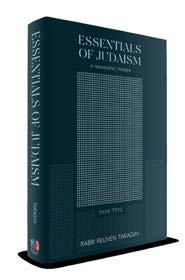

facilitate. We consider why our return to and rebuilding of Eretz Yisrael is so challenging and what further steps we must take to merit peace and the completion of our redemption.
May we soon see the complete and final redemption!
For suggested reflections and an expanded version of this essay, go to www.mizrachi.org/ hamizrachi.



In Essentials of Judaism, Rabbi Reuven Taragin comprehensively addresses hashka c ideals and behavioral standards. Based on the teachings of Pirkei Avos and Avos D’Rabi Nosson, this volume will stir readers to live life with increased awareness and meaning.
Rabbi Reuven Taragin is Educational Director of Mizrachi and Dean of the Yeshivat Hakotel Overseas Program.
ORDER AT RABBIREUVENTARAGIN.COM HASHKAFAH IS HOW WE UNDERSTAND OUR WORLD AND HOW WE ARE MEANT TO LIVE WITHIN IT PERFECT FOR THE UPCOMING PIRKEI AVOT PERIOD
Scan here to join Rabbi Taragin’s daily Divrei Torah WhatsApp group
RABBI TARAGIN WILL BE IN HENDON FOR SHABBAT

Heroines of Spirit –Sisters of Strength and Love
Rabbanit Shani Taragin
Lexicographers define the English vernacular of gevurah, “heroism,” as “fulfilling a high purpose or attaining a noble end” (Merriam-Webster), “exalted courage, intrepidity, or boldness” (Oxford), or “bravery” (Cambridge, Collins). Heroes are defined as “main characters in a narrative or dramatic work” (Oxford), “mythological or legendary figures often of divine descent endowed with great strength or ability, or illustrious warriors” (Merriam-Webster).
In Pirkei Avot 4:1, our Sages define heroism and heroes quite differently: “Ben Zoma said: Who is a gibbor? He who subdues his inclination, as it is said: ‘He that is slow to anger is better than the mighty; and he that rules his spirit than he that takes a city’ (Proverbs 16:32).”
In addition to the hundreds of thousands of soldiers fighting with extraordinary strength and spirit for the past seven months in defense of our Land, our nation and our values, there are many unsung heroines who have been standing by the sidelines on the Home Front. I am referring to the mothers, wives, daughters and sisters who stand behind the soldiers at the front, the soldiers who have been wounded, and the soldiers who have valiantly fallen. These women are heroines who have “ruled their spirit,” who have experienced intense anxiety, frustration, pain and unfortunately all too many losses, and yet somehow go on – with remarkable faith, resilience, and love for life and people of Israel.
Where does this heroism emanate from?
Some of their strength lies in our DNA, for we are great-granddaughters of Yocheved, Miriam and the righteous women in the Egyptian exile who while witnessing the deaths of thousands of Jewish infants, persevered and ensured the Jewish people would birth another generation. We also have the DNA of Queen Esther who proactively emerged from silence of acquiescence to selfless sacrifice on behalf of her people. And we also possess the will of
Devorah and Yael, unconventional “mothers of Israel” who looked evil in the eye and did not flinch.
The Midrash teaches of Hashem’s response to the destruction of the Beit HaMikdash: “The Holy One blessed be He said to Jeremiah: ‘Today I am like a person who had an only son, made a wedding canopy for him, and he died within his wedding canopy; do you not feel pain for Me or for My son? Go and call Avraham, Yitzchak, Ya’akov, and Moshe from their graves, as they know how to weep’… Avraham said before the Holy One blessed be He: ‘Master of the universe: Why did You exile my children, deliver them into the hands of the nations, kill them with all kinds of uncommon deaths, and destroy the Temple, the place where I elevated my son Isaac as a burnt offering before You?’... Yitzchak, Ya’akov and Moshe similarly beseeched Hashem to have mercy on His children as they sacrificed for the children of Israel! Moshe also said before Him: ‘Master of the universe, You wrote in Your Torah: “An ox or a sheep, it and its offspring you shall not slaughter on one day” (Vayikra 22:28). But have they not killed many, many children and their mothers, and yet You are silent?!’”
The known Midrash regarding the cries of Rachel Imeinu had also elucidated for me another source of gevurah, especially as I hear the cries of Binyamin Achimeir’s hy”d mother as I write these words: “At that moment, Rachel our matriarch interjected before the Holy One blessed be He.” Unlike the others, Rachel did not speak about her love or sacrifices for her children (though she died in childbirth!), nor did she focus on Ya’akov’s love and labor for her. Rather, she spoke of the suppression of her own desires, and her mercy on her sister; achoti, “my sister” is mentioned seven times in the Midrash! “‘I performed an act of kindness for [Leah], I was not jealous of her, and I did not lead her to humiliation’… Immediately, the mercy of the Holy One blessed be He was aroused and He said: ‘For you, Rachel, I will restore Israel to its place’” (Eicha Rabbah, Petichta 24).
Rachel emerges as the heroic matriarch not because of her love for her children, but because of her love for her sister. Hashem’s mercy is not sufficiently aroused when we display love for our children; parental love and discipline are both natural elements of the parent-child relationship. Rather, Hashem awaits true gevurah – conquering of jealous, fissiparous sentiments and inclinations towards our brothers and sisters.
Today, as I hear our heroines speak with love, unity and admiration about every demographic of Israeli society, downplaying protests and surmounting justifiable sentiments of resentment and anger, I am moved by their awesome gevurah – heroism that cannot fail to arouse Hashem’s mercy.
“So said Hashem to Rachel: ‘Restrain your voice from weeping, and your eyes from tears, as there is reward for your actions… And there is hope for your future… and your children will return to their borders’” (Yirmiyahu 31:15–16). Hashem awaits our love for one another as siblings to elicit His love for us as our Father. May the heroines of today inspire us with the gevurah to overcome negativity and embrace all of Am Yisrael as brothers and sisters!


Rabbanit Shani Taragin is Educational Director of Mizrachi and the Director of the Mizrachi-TVA Lapidot Educators’ Program.
RABBANIT TARAGIN WILL BE IN MILL HILL EAST FOR SHABBAT
| 19

El Malei Rachamim for Soldiers and 10/7
Rabbi Dr. Shlomo Brody
On November 17th, 1949, the young State of Israel buried 323 soldiers and citizens who were killed in Gush Etzion, Latrun, and elsewhere during the War of Independence. Stores were shuttered throughout Jerusalem as tens of thousands came to pay final respects during the first military funeral at Mt. Herzl. What prayer does one say on such an occasion?
The man arguably most responsible for making these burials possible was IDF Chief Rabbi Shlomo Goren. For weeks, he and his comrades made painstaking efforts to locate and retrieve the corpses and body parts of killed fighters. At times, they even entered minefields within enemy territory. Clearly, an appropriate tefillah had to be composed for this somber moment.
Rabbi Goren chose to adapt the classic El Malei Rachamim memorial prayer with the following tribute: “G-d, full of mercy… grant fitting rest… to the souls of the Israel Defense Forces that sacrificed their lives for the sanctification of G-d’s name, the nation, and the Land.” This became the basis for the prayer recited at all military funerals and on Yom HaZikaron.
A few weeks later, on the eve of Chanukah, the prayer was similarly adapted by the Israeli Chief Rabbinate to commemorate the Jews, known as “ma’apilim,” who died at sea while attempting to make it to the shores of Israel. As Dr. Yoel Rappel has shown, the text continued to be utilized after other tragedies. When an El Al flight was shot down over Bulgaria in 1955, killing 58, Rabbi Goren’s prayer commemorated the “holy souls of our brothers and sisters… whose blood was spilled over foreign soil.”
This powerful Israeli use of El Malei Rachamim is the latest way in which the storied prayer has been utilized to memorialize communal tragedies. The tefillah itself is first referred to in Yaven M’tzulah (“Abyss of Despair”), a book by Nathan of Hanover, who chronicled the Chmielnicki
massacres in 1648–49. He describes how a certain cantor, Reb Hirsch of Zywotow, mournfully chanted El Malei Rachamim over their brethren slaughtered in 1648, which caused everyone to break out in loud cries. An extended version is frequently attributed to Rabbi Yom Tov Lipman Heller, the author of the Tosafot Yom Tov commentary, who composed a selicha in 1650 to the memory of Rabbi Yechiel Michel of Nemerov and his community. Another version of the text appears in 1656 to memorialize the holy ones murdered in Warsaw and other Polish cities. It is considerably longer than the version that we have today, and reads more like a kinah lamentation recited on Tisha B’Av. Various versions of El Malei Rachamim were adapted for different tragedies, like the great 1689 fire in Prague.
Over time, the prayer was also utilized to commemorate the loss of individuals on their yahrzeit and in Yizkor. Rabbi Yosef Eliyahu Henkin argued that the same text should not be used for people who did not die as martyrs; his suggestion, however, was not accepted. Nonetheless, El Malei Rachamim remains at its core a prayer composed for martyrs.
In the midst of the Holocaust and soon afterwards, figures like Chief Rabbi Yitzchak Herzog wrote versions in memory of those murdered by the Nazis. At times, the language became contentious, as rabbis, politicians, and historians debated whether to detail the ways in which Shoah victims died (should “buried alive” be included?), their countries of origin (why mention some but not others?), and how to mark their murderers (Germans? Nazis? Their allies?). The details are symbolically significant, although most important in my mind is to make sure that we continue to recite one version or another as the number of survivors dwindle. Given this history, it’s not surprising that various versions of El Malei Rachamim have already been composed for the victims of October 7th and the subsequent war. One version, composed by IDF Chief Cantor

Abramson, is translated on the Ematai website.
To a large extent, the post-1948 versions of El Malei Rachamim continue the tradition of 1648. Yet we should never lose sight of one key difference. Since 1948, we not only memorialize those who died as victims but also those who gave their lives as defenders of the Jewish people. Today, the history of El Malei Rachamim tells both the travail – and triumph – of Jewish history.

Rabbi Dr. Shlomo Brody is the executive director of Ematai and the author of Ethics of our Fighters: A Jewish View on War and Morality (Maggid).
RABBI DR. BRODY WILL BE IN MILL HILL FOR SHABBAT
Shai
The funeral procession down King George Street for the 323 fallen soldiers. (PHOTO: WIKIMEDIA COMMONS)
20 |
The Greatest Story Ever Told
Sivan Rahav-Meir
Last year, more than a thousand people came to a Yom HaAtzmaut ceremony at the Young Israel of Woodmere synagogue in New York. Sivan Rahav-Meir was the keynote speaker. The following excerpts are taken from her remarks.
This week I heard the following question: In another 75 years, where will Israel be? Well, the most predictable thing about the Jewish people is their unpredictability. They break all the rules. There is no precedent for a nation that loses one-third of its people – six million – all at once. But then there is no precedent for a nation that was scattered to the four corners of the earth but kept its faith, its identity, and its homeland, and then rose from the ashes after two thousand years.
Most of the time, we are simply too preoccupied with our daily troubles and internal conflicts to zoom out for a brief moment in order to see the process that is at work. Sure, there are difficulties and setbacks, but the number of casualties from all the wars and terrorist attacks in the State of Israel is the same as the number of Jews who died in Auschwitz in a single month.
It is not unrealistic to predict that the nation of Israel will continue to fulfill all the positive prophecies that are found in the Bible. This is completely realistic. Indeed, these prophecies were read for thousands of years in Yemen and in Morocco, in Poland and in Russia, but for
us, these prophecies, such as the following one, have come true: “Old men and women shall yet sit in the streets of Jerusalem... And the streets of Jerusalem shall be filled with boys and girls playing.” These words of the prophet Zechariah have come to pass in the playground in my own neighborhood.
The forecast for Messianic times has been recorded as follows: “The wolf will live with the lamb and the leopard shall lie down with the kid,” and “Out of Zion shall go forth Torah and the word of the L-rd from Jerusalem.” Israel can and must be the world’s center of peace, creativity, education, and technology. Above all, the start-up nation must lead the world in spiritual start-ups of faith, holiness, and morality.
This week, I met thousands of our friends, Jews and non-Jews alike. I did not know we had so many unofficial ambassadors. Thank you to all of you in the United States who chose to be on our side, the right side of history, even when it’s not always popular to be there.
I am often asked as a journalist to name my biggest scoop. The answer is this: My biggest scoop is the story of the nation
of Israel. There is no story more exciting than ours, with more chapters still to come. Yom HaAtzmaut Sameach!


Sivan Rahav-Meir is a media personality and lecturer. She lives in Jerusalem with her husband, Yedidya, and their five children, and serves as World Mizrachi’s Scholar-in-Residence. She is a primetime anchor on Channel 2 News, has a column in Israel’s largest newspaper, Yediot Acharonot, and a weekly radio show on Galei Tzahal (Army Radio).
SIVAN WILL BE IN BOREHAMWOOD FOR SHABBAT
Translated by Yehoshua Siskin.
| 21
W




y Right
Led by Rabbi Larry and Rebbetzin Chaviva Rothwachs, Meromei Shemesh is building a vibrant diaspora-style community in the new Rotshtein Heights development, an extension to Ramat Beit Shemesh Aleph. With its shul as its spiritual and social core, Meromei Shemesh is an aspirational, growth-oriented, and Torah-centric kehilla that feels like a family.

• Modern, newly constructed upscale apartments with two, three, or four bedrooms
• Schools delivering excellent education and experience
• Shopping centers hosting your favorite stores, products, and necessities
• Parks with beautiful scenery and everything children could dream of
For more information, please contact: o@meromeishemesh com or 201-747-8740 or visit: www.meromeishemesh org



I N P A R T NE RS H I P W I T H
H E N TH
ME
O
TROY , WE B UI L D !
EY CO
T
DES

SENIOR RABBI
Mizrachi Melbourne is centrally located in the heart of Australia’s largest Jewish Community and is the city’s preeminent Religious Zionist Organisation.
Our current Senior Rabbi & Rebbetzin - Rabbi Dr Alan & Via Kimch returning to Israel in March 2025 at the end of a successful con Mizrachi Melbourne is therefore seeking to appoint another excepti committed couple to build on their outstanding achievements continue pathing the way forward towards our future growth.

Mizrachi is dynamic and multifaceted It embraces a range of synagogues, daily minyanim, Leibler Yavneh College (Crèche – Year 1 Torah MiTzion Beit Midrash and Midrasha, Kosher Australia, Emunah vibrant Bnei Akiva youth movement. It also has direct involvement Melbourne Eruv
Mizrachi is now searching for an innovative, energetic and ded Senior Rabbi who, together with an active and engaged Rebbetzi build on our impressive communal track record and further stren Mizrachi’s commitment to Torah learning, religious life and the St Israel
The successful candidate for this critical leadership positio
driven to build on our impressive communal track rec strengthen Mizrachi’s commitment to Torah learning, r the State of Israel;
an accomplished Torah scholar with broad secular proven experience in deciding halachic questions; an outstanding leader with strong interpersonal skills an effective teacher capable of engaging the commun able to drive communal growth with vision and imagin a passionate advocate for the State of Israel with a actively engage in communal religious and Zionist acti


For a confidential discussion or further information on this exciting opportunity please contact Mizrachi President - Benji Jotkowitz on + 61 419 008 500 Alternatively send your resume directly to president@mizrachi.com.au







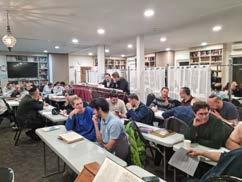



ד׳סב
Building this Land Together
Miriam Peretz
Following Yom HaAtzmaut 5783, World Mizrachi hosted the inaugural World Orthodox Israel Congress. Miriam Peretz, an Israel Prize Winner whose two sons fell serving in the IDF, gave a keynote plenary opening the Congress. While so much has happened in the past year, the words of Miriam Peretz ring as true as ever today.
To come here, after Yom HaZikaron and Yom HaAtzmaut, is not simple. These are days that weigh heavily on the families of fallen soldiers. You need time to process. There is no button that can just be pressed that ends Yom HaZikaron and suddenly we become happy. So, how do we do it? How do we continue?
I think about a piyut that we read on Rosh Hashanah, it is read by Jews from Morocco or Tunisia. The piyut is called The Time of the Gates of Desire (Eit Sha’arei Ratzon), and it is read before the blasts of the shofar. The piyut describes Akeidat Yitzchak, but includes this sentence: “The eyes weep in bitterness, and the heart is happy.” Am Yisrael is like that: the eyes weep in bitterness on Yom HaZikaron, but the heart rejoices for what we have on Yom HaAtzmaut. This is our nation. We are a people that knows how to mark the Holocaust, but also the revival that follows it. Destruction and rebuilding. We never leave behind the broken stones; instead, we pick up and gather the broken pieces and build a new building. And the biggest building that we have built is here.
Seventy five years ago, our fathers and mothers in Iraq, Poland, Germany, Tunisia, Italy, and everywhere in the world, had the same dream. The dream was one word: “Yerushalayim.” Yerushalayim is a code. It is the home of the freedom of a Jew. We thank Hashem that we are able to come to Yerushalayim, that we came home. We build buildings (sometimes too many buildings, it feels like we are becoming one big concrete jungle!) but we still need to build the most important building: the spiritual building. And who will do this? Mizrachi. Rav Doron (Perez), you have no idea what kind of influence you have on this building of the spirit of Am Yisrael
What is the spirit of Am Yisrael?
My son Eliraz had long peyot and wore a big kippah. He was a commander in the army, second-in-command of Golani’s 12th battalion. But when he returned from fighting, he never went straight back home, even if his family hadn’t seen him in a month. He could have been in Lebanon or Jenin for a month, but he would not go to his house. Instead, he would first go to the beit midrash. Why? In order to receive the spirit of our nation. Because with this spirit, it is impossible to break the nation of
Israel. The resilience of the nation of Israel does not depend on the amount of tanks we have. It depends on our spirit. The spirit of the Jewish people, the spirit of the pilots, tank drivers, and the citizens of the country – it is about this spirit that we fight for today, for this spirit to continue.
We came here and built it together. We brought our heritage and culture from all across the world. This is not at all normal. Am Yisrael is different from all other nations. When we left Egypt, it wasn’t only Ashkenazim or Moroccan Jews. Twelve tribes left Egypt, and each of them had a different flag. But what did they all have in common? When everyone held up their flagpoles, the one thing in the middle was the Mishkan. The spirit was in the middle, it united them. We continue with that spirit today. We also have our differences, which is fine. The biggest challenge we have today is living with others who are different, with respect for one another, recognizing the other. The Torah is not only found in me. When we pray, at the end of the Amidah we say “הֶ�שוע
He who makes peace in the heavens.” And what do we do when we say this? We take three steps backwards. You must move a little, in order to give space for another person. In order to listen to another person.
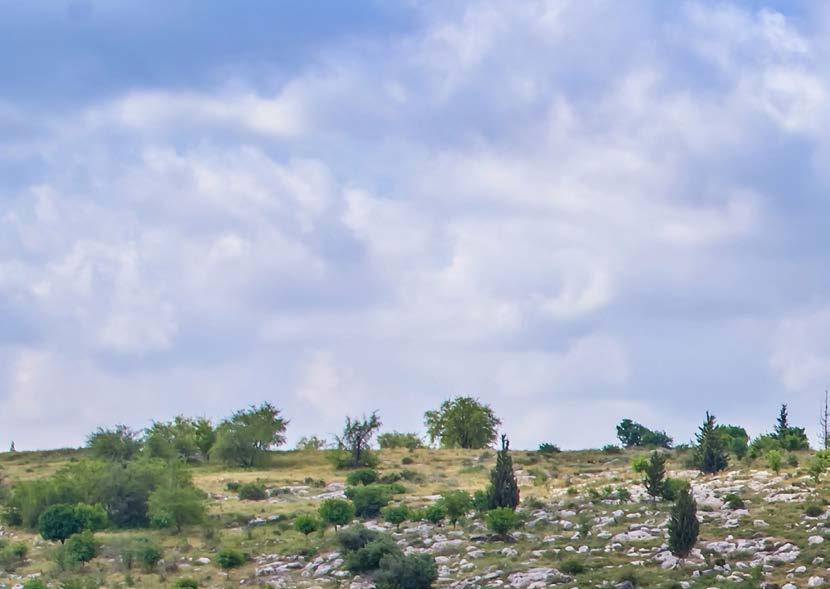
This land is not just the land of the Jews in Israel. This is the homeland of all Jews around the world! This is everyone’s homeland. There is a responsibility on all of us, you and I, to protect this Land. It is not just my responsibility, or my sons who fought in the army. They did not fight only for the citizens of the State of Israel – they fought for you as well. So that one day, when you want to come home, someone will have protected this home and have paid such a heavy price to keep this Land for all of us.
In the prophecy of Yeshayahu, he talked about what will be in the future, about peace: “And the wolf will live with the lamb” (11:6). He did not say that the wolf would become a lamb. He did not say that the religious will become non-religious, that the left-wing will become right-wing. He did not say this. The most important words he said, in my eyes, are “will live with.” To live together from a multitude of countries with all the differing opinions. Men and women, religious and non-religious, left-wing and right-wing, everyone. We need to learn to live together. And I want to tell you, that when I see you here, I see this unity. You
ויָמורְמב םֹולָ�ש,
24 |

are with us. Mizrachi sent you on Yom HaZikaron to the homes of bereaved families. You came to be with us on Yom HaZikaron, including in my home as well, there were people who came to sit with us. To feel, to be with us.
I feel that you are my brothers and sisters. When my children fought in battle, they protected our home. They didn’t check who lives in the home, whether the people living there are religious or right-wing. They fought for our home. They left to fight together, and their common goal was: to win and to return home safely. When they call each other, they don’t say “Ya’akov” or “Shmuel.” They call each other “achi, my brother” – always brothers.

In times of hardship we do not lose the DNA of the Jewish people, our mutual guarantee of responsibility for one another (arvut hadadit). I know that if I fell in the street, the person who would say “you are not my sister” would be the first to pick me up, because it is in our soul.
I am not a person who falls into despair; we have no right to despair. Am Yisrael is a nation that falls and gets back up. Am Yisrael is a nation that breaks apart but then rebuilds.
There are challenges along the way. I will never understand why HaKadosh Baruch Hu gave me this difficult test. I have a choice: I could choose to stay in bed and cry and accuse. But I have another choice: “choose life,” to continue to live. Why? Because on Yom HaZikaron we say that “they command us to live.” They did not fall for me not to live; they fell so we can continue to live here.
Everyone just wants to be deserving of their love for this Land, their sense of brotherhood, of friendship, to the spirit between them. I feel this is the spirit that you are cultivating here, and we stand united – not just at this moment, but we are always united. Blessed are the people whom these are their children. May there be better days and good news for all of Am Yisrael ◼

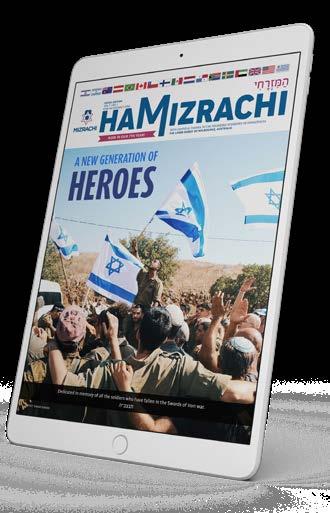
Your favorite articles are available to read and share online at mizrachi.org/hamizrachi ALSO AVAILABLE ONLINE!
Miriam Peretz speaking at the World Orthodox Israel Congress last year.
The Sirens
Ronit Chaya Janet

It has been many years since I heard the sirens.
It was in 2014, when I stood at a ceremony in the main street of Ra’anana and watched the faces of soldiers as they were projected on the walls of Yad L’Banim. Face after face of young people who had given their lives so that we could have a state. It was profound, but I cannot compare it to the powerful moment that occurred on the very next day, on the very same road, where we all stood still as a siren wailed. I watched as a young boy got off his bike and bowed his head in respect. The siren spoke to him, whispering the stories of those who had passed and those who had sacrificed. The siren drew to a close, and he rode on.
Just a few months later, on another visit, I heard a different siren, one that woke me from a deep slumber. It shouted: “Wake up! Get to safety! Get the children!” Our hearts pounded to the rhythm of the siren. We stood in hallways, bathrooms and shelters waiting for the “all-clear,” listening to the not-so-gentle booms of the Iron Dome that seemed to say “We’ve got your back.” The siren drew to a close, and we moved on.
This year as I approach Yom HaZikaron, my mind again hears the sirens of remembrance and warning. I see the faces of the slain soldiers, still fresh in our minds and new in their graves. I painfully remember the thousands of mourners carrying the blue and white coffins. I see the tears of mothers and fathers. I hear
the eulogies of siblings who never wanted to be alone. I feel the heartbreak of the fiancés who declare that these graves will be their homes.
This year, there are more new faces to remember, their images plastered all over my Facebook feed just days ago. Border Police, soldiers, civilians… all fighting a battle without warning, an enemy with a knife and a battle cry. The sirens of emergency vehicles, the frightening reality of calling to check in with family and friends who were locked down in a school, just minutes from the scene. You thank G-d they are ‘ok’ but in the same breath weep for the father whose last breath protected his child.
As a mother and teacher, I encourage my children and students to walk in the steps of Avraham, Yitzchak and Ya’akov in our Holy Land, to go on an Israel program for a few weeks or a year, or even to take the ultimate step onto the tarmac of BenGurion as Israel’s newest oleh. But then I think of the sirens, like the mythological creatures who enticed the sailors off their ships. Yes, these sirens echo in my mind, feeding my fears and doubts about walking the streets of our Holy Land.
But I also hear the reassuring voice of the late Rabbi Lord Jonathan Sacks zt”l as he explained how “religions of hope create healthy cultures of responsibility. This empowers us to take risks, engage in longterm projects, and refuse to capitulate in the face of despair. The flames of injustice,
violence and oppression are not inevitable. We must refuse to accept the world as it is… We are summoned to the long journey at whose end is redemption.”
Yes, we must heed the sirens; the sirens of warning, remembrance and protection. And we must acknowledge the fear and sadness that they bring. But we must know and remember that they are precursors to another cry, something far more redeeming and healing…
One day.

Ronit Chaya Janet is a multi-level educator, working at both Yeshiva College of South Africa and the Academy of Jewish Thought and Learning. She is the former editor of the South African Jewish Observer.
26 |
Building upon the Ruins of Sichon and Og
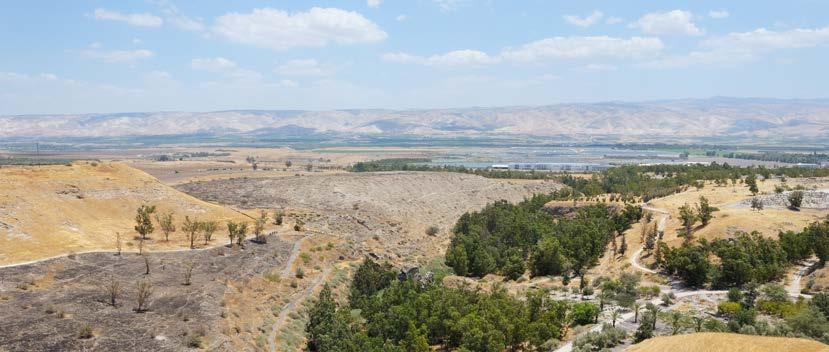
The conquest of the Land of Israel begins with the acquisition of the lands of Sichon and Og. This territory, located across the Jordan River, would ultimately be settled by the tribes of Gad and Reuven. Interestingly, it was the conquest of the lands of Sichon and Og that enabled Moshe to deliver his final address to the nation.
“It was in the fortieth year, in the eleventh month, on the first of the month that Moshe addressed Bnei Yisrael in accordance with everything that Hashem had commanded him to [tell] them, after he defeated Sichon the king of the Emori who lived in Cheshbon, and Og the king of the Bashan” (Devarim 1:3–4).
In order to understand the relationship between the defeat of Sichon and Og and Moshe’s address in Sefer Devarim, it is crucial to understand what these two kings, and their downfall at the hands of Bnei Yisrael, represent.
The conflict between Moshe and these kings calls attention to the sharp contrast between the Jewish concept of monarchy and that of other notions of government. The Jewish approach is rooted in the Torah’s perspective that the word of Hashem must direct the nation and its leadership, just as it guides the individual.
Sichon and Og represent two different forms of government. Rav Kook describes Sichon as a “fierce and ruthless king” who was characterized by “savage inner strength that would erupt without

constraint” (Olat Re’iyah 2, 83). His form of government is predicated on the ruler’s power and tyrannical control of his nation. Throughout history, there have been countless despots whose subjects were intimidated by their rulers’ complete lack of restraint and were terrified of disobeying their orders. Sichon’s character is illustrated by his reaction to Bnei Yisrael’s simple request to pass through his territory. Being a fearsome and intolerant tyrant, Sichon refused to comply.
In contrast, the leader of the Jewish camp –Moshe – was perfectly refined and humble. His nation did not fear him; rather, they submitted to his authority because they viewed him as a faithful emissary of Hashem. Far from being a cruel tyrant, he was a paragon of self-restraint. Moshe’s example served as a powerful statement to the world: that it is possible to govern with kindness and compassion, rather than resorting to tyranny and intimidation.
Og employed a different style of governance, one that is more commonly encountered in modern times. Og ruled over a rich and fertile land. Og himself was an imposing giant of a man, the embodiment of physicality. His subjects did not submit to his authority out of fear; rather, they were motivated by the promise of material gain.
The king of the Bashan was among the “remnant of the [giant] Refaim” (Devarim 3:11). As a king who ruled over his nation in line with his personal mindset, he
defined success and fulfillment exclusively in terms of material dominance (Rav Kook, Ein Ayah, Berachot 2:9:8). Og’s style of leadership exists in many contemporary societies where political leaders often gain power by promising financial benefit.
The Talmud relates that Abba Shaul once chased a deer through a huge thigh bone, which turned out to belong to Og (Niddah 24b). Aggadic stories such as these are generally interpreted by commentaries as dreams, visions or metaphors, and there is certainly a metaphoric lesson here: A person should pursue purity, symbolized by the deer, not coarse materialism, represented by Og’s thigh bone.
The collapse of the kingdoms of Sichon and Og represented the failures of their respective worldviews – the beliefs that a kingdom could be built on strength and intimidation or on the promise of material bounty alone. It was only after Moshe defeated Sichon and Og, thereby negating their approaches, that he could teach the people how they were to live as a nation in Israel. Today as in ancient times, the struggles between Israel and its enemies are actually a reflection of a battle between competing ideologies and value systems.
Translation: R. Dovid Sussman
Editing and adaptation: R. Yitzchak Twersky, Academic Language Experts
Siman Labanim is a ground-breaking English translation of Rav Kashtiel’s popular collection of shiurim on the weekly parasha. With this publication, his uplifting writings are accessible to a wider audience. Rav Kashtiel, the Rosh Yeshiva of the post-army program of Bnei David in Eli, is the author of many volumes of parshanut on the Tanach and has long been one of the most prominent Religious Zionist voices in Israel today. If you wish to purchase the sefarim, please contact Maura Ruskin at +972-523826844 or by email at maura.ruskin@gmail.com
| 27
Rabbi Eliezer Kashtiel
Manna and Miracles Lessons from the Desert
Rabbanit Sharon Rimon
After the Israelites’ period in the desert, when they were indoctrinated into a life governed by the will of G-d, they arrived at the border of the “good Land,” as described at length in Devarim 8:7–10. Life in the desert was not an ideal way of life but merely a “series of lessons” that Israel must learn in preparation for entering the Land.
Life in the Land, one overflowing with bountiful abundance, would be completely different from life in the desert. The contrast between “He afflicted you and starved you” in the desert and the abundance in the Land of Israel is salient. In the sparse desert, the people ate in order to survive, but in the Land of Israel – flowing with water and rich with fruit – they would eat to satiety.
This seems to be an appropriate ending to the chapter: after the desert’s “series of lessons,” the Israelites would – having internalized the awareness that all blessings come directly from G-d and having learned to live a life fully governed by G-d – be worthy of inheriting the Land. However, it appears that, despite their lengthy desert education, the people of Israel were still not immune to forgetting G-d, and Moshe Rabbeinu saw fit to warn them accordingly. Although G-d had educated the Israelites to place all their trust in Him during times of hardship
and crisis, that did not guarantee that they would place all their trust in Him during times of plenty. That is because, when a person is accustomed to receiving bounty in a natural, material way, he is liable to grow arrogant and forget that it is G-d who is bestowing all of this goodness upon him.
Therefore, in the concluding section of chapter 8, Moshe describes the desert period from a slightly different perspective. He describes how terrible it was and how it was fraught with dangers like snakes, scorpions, and lack of water. In those circumstances, G-d was Israel’s benefactor, Who made their journey through the desert possible, brought water out from the rock, and gave them manna.
Thus, according to this concluding section, Israel received G-d’s kindness in the desert, an experience meant to imprint awareness of the Source of all good on their minds and lead them to recognize that everything good comes from G-d: “And you shall remember Hashem your G-d, for it is He who gives you strength to produce wealth” (Devarim 8:18).
In this concluding section, Moshe describes the Israelites’ desert years as a time when G-d provided for all of their needs in a miraculous way. Water flowed from the rock and the clouds of glory surrounded them, protecting them

from snakes and scorpions and smoothing the way before them. The purpose of this period was to imbue Israel with the quality of gratitude and to prepare them for the abundance awaiting them in the Land of Israel.
When everything comes to a person directly from G-d, without any effort on his part, he is liable to take everything for granted rather than recognize that this abundance is a gift from Heaven. How can a person be thankful to G-d for saving him from snakes and scorpions when he is wrapped in the protective clouds of glory and has never even seen a snake and scorpion?
For this reason, G-d gave the Israelites the manna. Its purpose was to teach them an important lesson. “Who gave you manna to eat in the desert, something your ancestors had never known, to afflict you in order to test you so that in the end it might go well with you?” (Devarim 8:16). Although the manna was one of the good things that G-d bestowed upon Israel, it had a certain aspect of affliction and trial, and, as such, it prepared Israel for the goodness that they would receive in the future.
How was the manna a trial and affliction for Israel?
The manna was given to the Children of Israel in order to solve the problem
28 |
of hunger in the desert. In this sense, it is similar to the water that flowed from the rock, which solved the problem of thirst. However, unlike the water, which – although it was produced in a supernatural way – was an ordinary substance, the manna was a new creation whose very existence was miraculous.
The wondrous quality of the manna was a constant reminder of its Divine source. The manna was unknown in the world before this time – “that you did not know and that your forefathers knew not” – and was created for Israel’s needs in the desert. The procedure of collecting the manna was subject to strict rules, unlike usual eating. A specific amount had to be gathered, none could be left for the next day, and twice as much had to be gathered on Fridays. The manna followed Divine rules: it would rot overnight but not on Fridays and, according to the Midrash, no matter how much each person gathered, he would always end up with the same amount. Finally, the people were aware of their dependence upon the manna, which fell anew each day, and only enough for that day (except on Fridays).
The manna’s unique quality complemented the Divine profusion of the clouds of glory. Unlike the clouds of glory, whose purpose was to fulfill the people’s needs completely, to the extent that they were not even aware of the dangers they faced, the manna was a gift that served as a constant reminder of unceasing Divine abundance.
Thus, the manna functioned as a test for Israel. In the plainest sense, it tested whether they would follow G-d’s instructions on how to gather the manna – not to gather more than required for that day, not to leave over for the next day, and not to go out gathering on Shabbat. But the manna was also a psychological test. The people had to be completely, utterly dependent on G-d, having faith that He would bring down manna from
the heavens every day, without having any food stored for times of need. The manna forced the Children of Israel into a perpetual state of utter dependence on G-d.
The people expressed their cravings for a richer, diversified menu, complaining about the monotony of the manna and concluded, “We never see anything but this manna!” Ramban explains: “[The people] said, ‘We never see anything but this manna. Even the food we live on is not in our hands, so that we would feel full and satisfied. But we constantly desire it and lift up our eyes to see if it is coming. All we have is our hope for the manna.’ Regarding the nature of this affliction, our Sages (Yoma 74b) expressed the well-known analogy that a person who lacks a loaf in his basket is not comparable to a person who possesses a loaf in his basket” (Ramban, Bamidbar 11:6).
On the one hand, the manna was a gift from above, bestowed upon Israel in G-d’s kindness, which enabled their existence in the desert. But on the other hand, it was a perpetual test, a difficult trial.
As the Israelites stood at the threshold of the Land of Israel, a land flowing with milk and honey, Moshe twice mentioned their time in the desert so that they would not forget the important lesson that they had learned there. The Israelites’ time in the desert taught them to trust in G-d, Who controls and rules all, and to know that everything – both the good and the bad – is governed by Him. Moshe described the years spent in the desert in two different passages, teaching Israel that there are two realities that may lead a person to stop keeping the mitzvot: either crisis and difficulty, when a person may feel that G-d is not helping him, or even that G-d is afflicting him, or abundance, when a person’s life is so filled with earthly goodness that he may forget the true Source of goodness.
The manna was an answer to both of these potential states of mind. On the one hand, a person could learn from it that even in times of difficulty and affliction, G-d bestows goodness on humanity. Then he would realize how his life is governed by G-d and understand that G-d was teaching him a lesson through hardship, just as parents educate their children: “For by every word that proceeds out of Hashem’s mouth does [a person] live…” (Devarim 8:3), “And you shall know in your heart that as a father disciplines his son, so Hashem your G-d is disciplining you” (ibid. 8:5). The Children of Israel must remember the lessons learned in their collective “childhood” in the desert, where they “grew up” before arriving upon the border of the Land of Israel with all of its abundance.
On the other hand, manna represented constant abundance, which must not be taken for granted. The manna taught Israel that they were entirely dependent on G-d, and that this would also apply in the times of abundance when they would enter the Land of Israel. Even when they would become people of wealth, they must remember that their wealth comes from G-d: “And you shall remember Hashem your G-d, for it is He who gives you strength to produce wealth” (Devarim 8:8).


Rabbanit Sharon Rimon teaches Tanach and is Content Editor for the HaTanakh website.
| 29
A Wounded Warrior’s Road to Healing
A Conversation with Shlomo Klein

Since October 7th, close to 3,200 IDF soldiers have been injured –half in the initial days, and half since the ground invasion of Gaza. Behind that statistic lies literally thousands of remarkable stories – of pain, perseverance and the long road to recovery.
Rabbi Aron White spoke with Shlomo Klein, who was injured on October 7th, underwent numerous operations, and has undergone 5 months of rehabilitation at Sheba Medical Center.
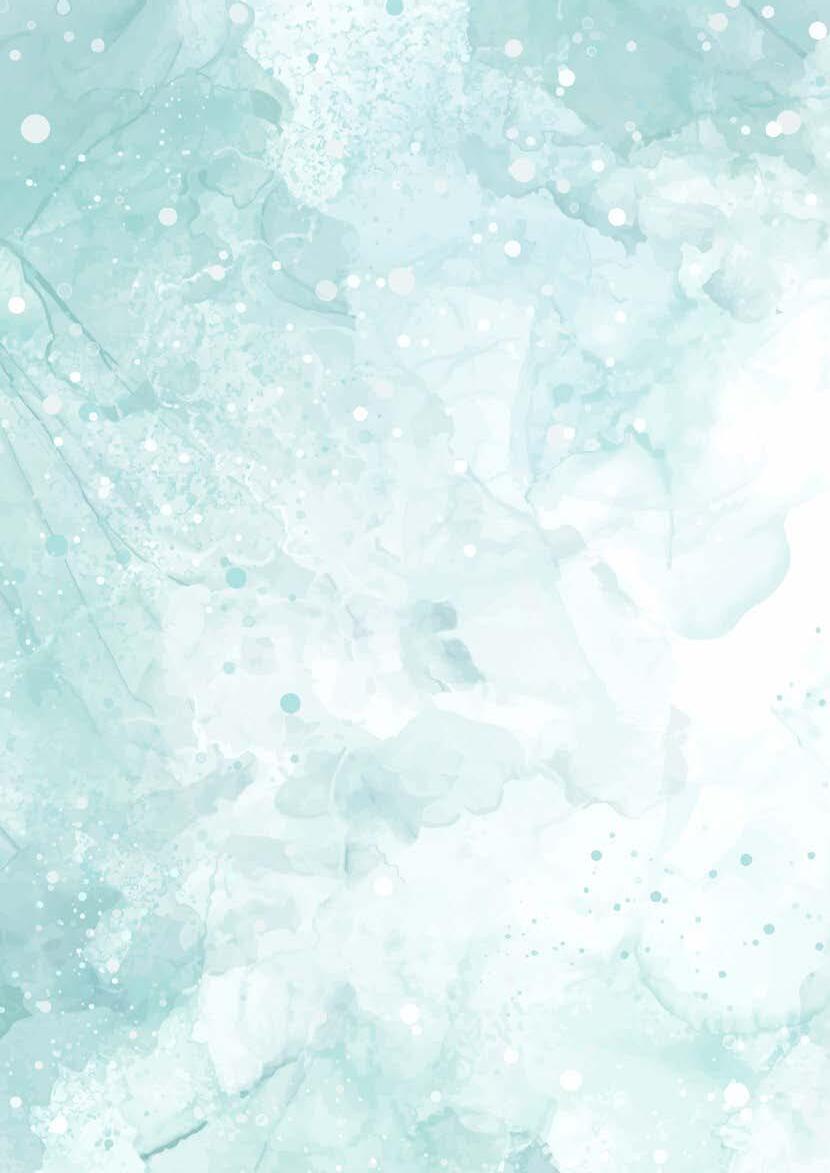
On October 7th, you were in an army base close to the Gaza border, serving in an elite unit, Sayeret Nachal. How did you come to join that unit?
I grew up in Efrat to Canadian parents, and after graduating high school went to Ma’alot Yeshiva. Like many of my contemporaries, I tried getting into an elite unit of the IDF, and was accepted for the tests to get into Sayeret Matkal. I didn’t pass the test, but was then accepted to Sayeret Nachal. I joined with my friends from Ma’alot, and underwent a year and two months of training. The first place we were posted was at the Gaza perimeter.
On the morning of October 7th, I was in Mutzav Sufa when the sirens went off. I grabbed my gun and ammunition, but didn’t have time to get my full gear on. Our mefaked told us there were terrorists breaking into the base, and we ran across
the base to engage them. I would end up engaging about 15 of the 60 Hamas terrorists who infiltrated the base. We ran into the dining room, and the terrorists were on the other side of the wall. I was steeling myself, counting down to 3 to get ready to go around the wall and engage them, when they threw a grenade at us. I was able to evade it, and only got some shrapnel in my back. We were defending from around the wall, shooting and taking down some of the terrorists, when my friend who was next to me, Hallel Sa’adon, was killed. After a few seconds, I was worried they were going to take Hallel’s body, so I reached out my right hand to pull his body back to me – and that’s when I got shot in the lower arm.
I pulled back, and started screaming at my friend to apply a tourniquet above my elbow, to cut off the blood flow to ensure I don’t bleed to death. I was in tremendous
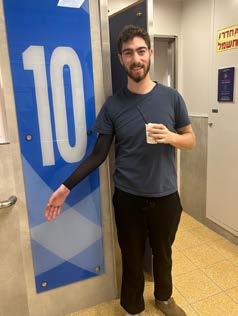
pain from the bullet and the tourniquet, and my friend followed protocol and ripped off the rest of my clothes except underwear, to ensure I wasn’t bleeding anywhere else. After I stabilized, I had to maneuver myself with one arm to try and get to the safest place that I could behind a wall.
For the next 5 hours, we were waiting for backup forces to come and rescue us. I tried my best to continue fighting off Hamas, but with only my left arm available, there were only so many shots I could take with my 15-pound Negev gun. I was lying on top of other soldiers, some dead and some alive. There were about 15 grenades thrown into our area, and each time I would protect my head with my left hand, say Shema, and be very thankful I was still alive after the explosion. As it was Simchat Torah, I sang Simchat Torah songs to myself, and even leined to myself
(PHOTO: DROR FARKASH) 30 |
the parts of my Bar Mitzvah parasha that I remembered by heart.
What happened when the backup forces arrived?
When the Shayetet 13 (Navy Seals) arrived, we didn’t know if we could trust that they really were the IDF, since they could have been Hamas terrorists pretending to be in the IDF. They shouted out Shema Yisrael, Chag Sameach, and other ways to identify themselves, and our group lowered their weapons to allow them in. I was covered in blood, in pain and very dizzy, and one of them helped me out of the base. We got out of the base at 2:15pm, but by 3:00pm we still hadn’t been picked up by a helicopter to be taken to a hospital, since there were so many casualties all over the region. I got into a car, with six or seven other injured and dying soldiers piled into the back, and I was ready to drive us with only my left hand to Soroka Hospital in Be’er Sheva, as we all really needed medical attention. A female officer talked me out of it, and she took the wheel. Eventually we met up with a helicopter at a landing spot, and were all taken to Soroka Hospital.
At Soroka, I was operated on, about nine hours after I was shot and my arm had been placed in a tourniquet. When I woke up, the first thing I noticed was that I still had my right arm. My parents later told me that when the doctors went in for surgery they weren’t sure if they’d be able to save my arm. But in the first operation to remove the bullet, they were able to save the arm.
Soroka was overwhelmed with so many people, and so my parents arranged for me to be moved to Hadassah Ein Kerem in Jerusalem. By the time I arrived there, I had a serious problem with my kidney. Because I had the tourniquet on my arm for nine hours, large amount of toxins
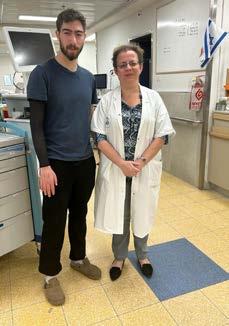

months
built up, and my kidney was failing. The doctor told us to pray that it would return to functionality, and thankfully it did.
For the next few weeks in Ein Kerem, I had an operation every three days on my arm, because of the damage caused by having no blood flow to it for 9 hours. I had surgery every Sunday and Wednesday. After a total of seven surgeries, I was transferred to Sheba to begin my rehabilitation.
What does rehabilitation involve?
Every day I would have physical therapy, occupational therapy, and often psychology. I arrived at the beginning of November. On January 11th, I moved my right bicep independently for the first time. On January 28th, I moved my right wrist for the first time. At the end of March, I reached the milestone of being able to pick up a cup and take a drink of water. I am now an outpatient, traveling from Efrat to Tel HaShomer four times a week. They


still have to see in a few months how my nerves are doing.
What was your mood like during these months?
Honestly, at points it’s been pretty difficult, and I sometimes got irritated with my friends and the medical staff around me. However, I’ve been surrounded by so much support from my family, and the army has sent lots of support too. It’s been nice having groups visit from chutz la’aretz as well. Sometimes it can be a bit much, but they have also given generous gifts –one group gave me a new MacBook! ◼
When I met with Shlomo, World Mizrachi Co-President Rabbi Yechiel Wasserman joined the meeting as well. 50 years ago, Rabbi Wasserman was in Sheba Medical Center for his own rehabilitation, after being injured in his tank by the Suez Canal. His wedding was delayed, and he was only released from the hospital eight months later.
Since the founding of the state, thousands of Israel’s soldiers have been wounded and left with scars, both physical and psychological. That is the sacrifice paid by the defenders of our country. Shlomo, alongside thousands of other IDF heroes injured in this war, is doing what it takes to move forward with his life. Let us never forget their sacrifice.
Shlomo with Dr. Anna Weitzman, the head of the rehabilitation unit at Sheba hospital.
| 31
After
of rehab, Shlomo drinking from a cup independently with his right arm for the first time.

“Great in our Midst” The Ongoing Miracle of the State of Israel
Rabbi Jonny Brull
“Shout for joy, you who dwell in Zion, for great in your midst is the Holy One of Israel” (Yishayahu 12:6).
This verse concludes the haftarah traditionally recited on Yom HaAtzmaut. The utopian messianic paradise described by the prophet Yishayahu, wherein the “wolf shall dwell with the lamb” and the “lion like the ox shall eat straw,” culminates in the above proclamation, that the inhabitants of the Promised Land should joyously exclaim G-d’s greatness in their midst. But in what sense, precisely, is G-d portrayed here as being “great” in the midst of Zion?
Ibn Ezra writes: “It is proper that you should raise your voice, O daughter of Zion, for the Divine Presence is in your midst.” Ibn Ezra opts for a more literal reading of the verse, namely, that it is quite simply the increased revelation of G-d’s presence in Israel that is the cause for joy. G-d’s shechinah is literally “great in our midst”: G-d has returned to Zion and is among His people once more.
An alternative explanation for this verse, however, is found in a careful reading of Radak’s commentary. He explains that “G-d’s name is great in your midst, through the miracles that He has performed.” In stark contrast to Ibn Ezra, who emphasizes the overt manifestation of G-d as the source of elation, Radak’s reading here implies that it is through G-d’s deeds that He will truly be revealed in times to come. Radak’s interpretation is most appropriate when we apply Yishayahu’s prophetic words to Yom HaAtzmaut. It is very easy to look at the modern, primarily secular State of Israel through a critical lens. Certain sects of Judaism scorn the celebration of Israel’s independence as a G-dless
endeavor. Radak’s exegesis to the verse in Yishayahu provides us with the response: We cannot deny the miraculous nature of Israel’s inception – the wholly unlikely act of the establishment of the State of Israel is testimony to G-d’s great name in our midst. It may be a secular state, but its very existence is nothing short of a miracle. G-d is indeed “great in our midst,” not through blatant messianic revelation, but through the wonders He has performed in establishing the Jewish state.
During my service in the Israeli army, I was once asked by a secular soldier why I had chosen to make Aliyah and join the IDF. “You could be studying at university in your hometown of London right now,” he noted with incredulity, “and instead, you are standing on guard duty on some random hilltop at two o’clock in the morning with me!” I responded to him that the very premise of his question was erroneous. “This is not ‘some random hilltop,’” I replied. “It is the Land which was promised to our forefathers, where our ancestors twice established a kingdom. I feel more closely connected to this Land than any location in London or anywhere else in the world.”
The close connection so many of us feel to our homeland can be described as twofold in nature, in a similar fashion to the Mishkan. On the one hand, the Mishkan is described as the “ohel moed,” the “Tent of Meeting.” It was fundamentally a place where man meets G-d and seeks out His presence. Yet, simultaneously, it is also called the “Mishkan haEidut,” the “Sanctuary of the Testimony,” wherein the luchot haEidut, the two Tablets, were kept, exemplifying its role as the home of Torah. Thus, the Mishkan – and later the Beit HaMikdash in Jerusalem – was both a
place where G-d’s presence rested and the center of Torah.
I believe that the entire Land of Israel serves this dual purpose. On the one hand, Israel has boomed as a central hub for Torah study. Unprecedented numbers of yeshivot and midrashot are flourishing, with masses of students flocking to the Promised Land from all four corners of the earth each year. Never has Torah been more accessible to the entirety of the nation, and never in modern times has one location on Earth held that status as the center of Torah learning.
At the same time, Israel is undeniably the center for spirituality, the place where G-d can be felt more than anywhere else in the world. Not just at the Kotel, but throughout the bustling streets of a land long left barren, the revival of Jewish activity in the land is simply the voice of G-d calling to us through the modern state. That is how Radak understands the words of Yishayahu, and it is that feeling which I conveyed to my fellow soldier on that hilltop in the small hours of the night.

Rabbi Jonny Brull is Rosh Kollel Torah MiTzion at Mizrachi Melbourne. He learned for ten years at Yeshivat Har Etzion, and has a B.Ed in Torah Shebe’al Peh and Hebrew Language from Herzog College and an M.A. in Jewish Education from the Hebrew University.
32 |







Achievements of the representatives of the Orthodox Israel Coalition in the National Institutions as part of Mizrachi’s global representation.
30,000
participants in international conventions for strengthening the connection to the State of Israel
2 million
NIS towards supporting solidarity delegations during the war
290
Teacher Shlichim in 126 schools in 97 cities worldwide including over 200 in schools across the US
27 million
NIS raised for youth villages and Israeli Religious Zionist institutions
4 million
NIS towards activities in Religious Zionist communities across the world
34 |



88 million
From the front lines of the IDF to projects around Israel, World Mizrachi has been playing its part in the war effort in Israel.

NIS raised benefiting 50 yeshivot and seminaries and 3,000 gap year students from the US through Masa funding and annual Mizrachi Causematch campaigns since the last World Zionist Organization election
4,000
yeshiva and seminary students participated in educational activities, including Yom HaZikaron and Yom HaAtzmaut events
600
Religious Zionist shlichim including 380 across the US will be in communities across the globe in 5784, coordinated by the Shlichut Center
2 million
NIS towards Religious Zionist activities across France with 100 guest speakers, and supporting absorption of French olim

1,000,000+
views on digital content and inspiration connected with the war
90+
Mizrachi missions to Israel from 14 countries around the world


3300+
letters and videos received from 13 countries sent to soldiers and schoolchildren in Israel
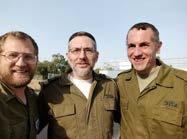


40,000
soldiers received crucial equipment through the Sulamot/Tzevet Perez campaign, including 5,000 ceramic vests



160+
members of Mizrachi staff, program participants and shlichim serving in the IDF
Roi Abecassis Deputy Chairman, KKL
| 35
Gael Grunewald Deputy Chairman, WZO
Olim Giving Back to Israel

Joey Sacharow
My name is Joey Sacharow. I’m a medical licensing specialist with NBN’s International Medical Aliyah Program (IMAP). I made Aliyah in 2013 from Baltimore, Maryland and enlisted in the IDF as a lone soldier. This was my second Aliyah, as my parents came when I was a baby and stayed only for a short while. Returning to Israel on my own was always a dream of mine. It was also important to me to make Aliyah and serve in the IDF. I served in the infantry as a combat medic and as company medic in my battalion’s medical platoon.
On the 7th of October, my wife, our son, and I were visiting family in the United States. Within a day of returning, I joined my unit along the Gaza perimeter. A few weeks later, we were already in Gaza with the objective to secure the humanitarian corridor.
The war sadly goes on. Since I haven’t hung up my uniform for good, there hasn’t been much opportunity to reflect on my time in and out of Gaza. But I do vividly recall our first Friday night deep in Gaza. In near complete darkness, we hastily sang the songs of Kabbalat Shabbat. As we were preparing kiddush, my thoughts were with my family. Whenever I’m away from home on Shabbat, I give my son a blessing from afar. I shared with my guys that I was about to bless my son and asked permission to say it out loud and with them in mind too. Every single soldier said yes and gathered nearby. I told them that beyond the bond we shared as brothers in arms, that there were times as their medic, I felt like a parent and that I loved them as such. Closing my eyes, stretching out my hands, and over the sounds of war around us, I asked G-d to bless, protect, and to grant them peace. After a collective ‘Amen’ and the exchange of a few hugs, we sat down to our modest meal. That moment has stuck with me every Friday night since.
We understood that we were fighting for Jews everywhere, not just here in Israel. Our survival as a people is rooted in our return to the only place we have ever truly called home. It’s a privilege to have not only answered the call to make Aliyah myself, but to also defend that right for others to do so as a soldier in the IDF.
Yisroel Weiss
Making Aliyah is probably one of the hardest decisions people can make in their lifetime. But it is so, so worth it. Yes, there will be challenges, but they will make you stronger because of them. I cannot possibly advocate for Aliyah more; it is definitely worth it to be able to live and raise a family in our ancestral homeland. Your future generations will thank you for it!
My name is Yisroel Weiss. I made Aliyah from Toronto, Canada because I used to come with my family to visit for the chagim and absolutely fell in love with the Land and the people. I told everyone my goal was to make Aliyah before I turn 30. And that’s exactly what happened.
Since October 7th, together with Just One Chesed and an excellent team of volunteers, we have thrown ourselves completely into doing whatever we can for the chayalim, their families, as well as displaced people. We started the morning of October 8. It has been an initiative run almost entirely by olim who felt it was their obligation to contribute to the war effort as many of our neighbors were called up to reserve duty. Many of us volunteer all morning before starting our regular jobs in the afternoon. To date, we have distributed over $5 million of supplies to soldiers all over the country. Though at times we focus on our differences, the Jewish nation of Israel is truly one family. I have a colleague who lives in Rechovot, and we live different lifestyles. Last Pesach, after three members of the Dee family were tragically murdered, my co-worker immediately reached out to me to see how my family and the Efrat community were doing. Just a few short weeks later, a rocket from Gaza hit a building and killed a person in Rechovot right near where my co-worker lived. After checking in on my co-worker, I stopped to reflect on how we all are one nation, one people.
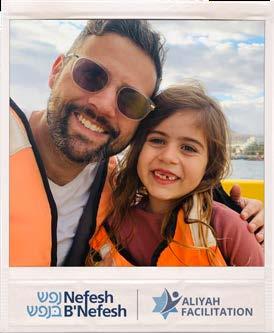
Follow NBN on social: NefeshBNefesh linkedin.com/company/nefesh-b’nefesh/ nefeshbnefesh


THE TIME IS NOW ALIYAH:
WWW.NBN.ORG.IL WORKING IN PARTNERSHIP TO BUILD A STRONGER ISRAEL THROUGH ALIYAH
Fold a square of paper in h
COMPILED BY: JACQUI
AUSTEN
DESIGNED BY: LEAH
RUBIN
How to make a kite to fly at your Yom HaAtzmaut BBQ!
Materials you will need:
2 sticks, one being 4 cm shorter than the other one
Strong tape
Plastic table cloth or large garbage bag
Long string or yarn (at least 100 meters/300 feet)
A small piece of cardboard to wind the string onto Ruler, scissors and a marker

Tape down each end of each stick securely to the plastic.
Lie the shorter stick horizontally across your bigger stick, a few cm from the middle and tape the sticks together where they crossover.
Cut a piece from the string that is two times the length of the horizontal stick and set aside.
kids corner


Flip the kite over and take the rest of your string and tie it to the middle of the looped string on the front of the kite.
Poke a hole on each side of the horizontal sticks just past where the tape was put.
Flip the kite over, take the string from step #2, and thread each end of the string through one of the holes.
Take the end of the rest of the string and wrap it around the cardboard.
Cut out a long tail from the leftover plastic.






Take the taped sticks and lie them on the tablecloth/garbage bag and trace a diamond shape on the bag. Then, cut out the traced diamond shape.
Flip the kite back over and tie each end securely to the stick. Repeat on the other side.
Attach it to the bottom end of the longer stick with tape to act as a tail so that the kite can fly well!
take the kite out to your bbq and run with it when the wind starts to pick up!
יִחִָרְָזְִמִַּהַ
1 2 3 4 5 6 7 9 10 11 8
38 |

Meet Geulah Cohen
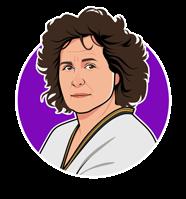
Every year, about 1,000 letters are sent to Jerusalem, Israel, that are addressed to Hashem.
Israel’s cows produce more milk than cows from other countries.
Israeli banknotes have Braille on them.
December 25, 1925 - December 18, 2019 (8 Tevet 5686 - 21 Kislev 5780)
Geulah, one of ten siblings, grew up in Tel Aviv and joined the underground to fight the British when she was seventeen. Due to her strong Hebrew accent, she was chosen to be the announcer on the “Voice of the Jewish Underground” radio station, but was caught by the British in 1946 in the middle of a broadcast and was sentenced to nine years in jail. She managed to escape two different jails and helped edit the Lehi newspaper, The Youth Front. When the State of Israel was established, Geulah tried to be elected to the Knesset; when she was unsuccessful, she became a journalist and writer. Later, in her fifties, Geulah was elected a Member of Knesset where she served for nineteen years working to bring Soviet and Ethiopian Jews to Israel. Until the end of her days, she was a passionate revolutionary who refused to compromise on her political beliefs. When Geulah Cohen was asked how old she was, she said: “I am four thousand years old, like this nation; seventy like the state; ninety-two like my biological age — but I am always eighteen.”

Adapted from Iconic Jewish Women by Dr. Aliza Lavie. Scan the QR code to purchase on Amazon.
Test
Knowledge
Your weekly parsha for youth!
What was the Hebrew and English date of the founding of the State of Israel?
How many Jews were living in Israel at the time of the founding of the State of Israel?
Which location in Israel is the lowest point on Earth?
HaMizrachi Weekly Youth Edition & Chavruta Featuring Thought-Provoking Questions, Fun Activities, and Fascinating Insights!

Decode the Quote
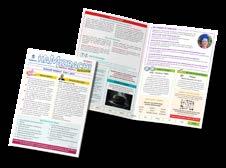
Scan the QR code or visit mizrachi.org/youth to learn more.
Use the symbol key to decode a famous quote by David Ben Gurion, the first Prime Minister of Israel.
 Look for the answers in the Parshat Emor Youth Edition – see below for more details!
Look for the answers in the Parshat Emor Youth Edition – see below for more details!
SHEMOT THE BUSH Similarly, project bush. burning take יִחָרְזִמַּה PARSHA CHAVRUTA asked answered, beautiful Hashem Hashem
| 39
Dancing Tears
A Global
Project To Unite
the Jewish world and Honour The Memory Of The 1,200 Souls Lost On October 7th and the many hundreds since.
On the morning of October 7, 2023, Simchat Torah, the Jewish community faced its most horrific day since the Holocaust, with over 1,200 lives cruelly taken and many more held hostage.
This tragedy has bonded us in deep collective sorrow. As the Jewish world remains united in grief, we are challenged with the difficult questions: How do we move forward from such a profound loss? How do we celebrate Simchat Torah 2024 and beyond?

Join The Simchat Torah Project 2024 - a global project to honor the first yahrzeit of the October 7th tragedy.
Together we will commemorate the resilience of the Jewish people and remember those we lost by 1,600 Torah scrolls being covered with an identical beautiful Torah Cover in memory of the 1,600. One name for every Torah.
YOUR Community can be one of the 1600 Communities involved in this project.
Next Simchat Torah with tears in our eyes we will dance! 1,600 Torahs uniting 1,600 Communities across the world. Register Today! TheSimchatTorahProject.org
“There is a time for everything under the Heavens... a time to mourn and a time to dance...”









 Rabbi Andrew Shaw is the Chief Executive of Mizrachi UK.
Rabbi Andrew Shaw is the Chief Executive of Mizrachi UK.















 Rabbi Danny Mirvis is the Acting CEO of World Mizrachi.
Rabbi Danny Mirvis is the Acting CEO of World Mizrachi.







































































 Look for the answers in the Parshat Emor Youth Edition – see below for more details!
Look for the answers in the Parshat Emor Youth Edition – see below for more details!
